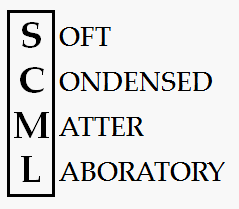Andrea Scotti, Emily Herman, Akriti Singht, L. Andrew Lyon, Urs Gasser, Alberto Fernandez-Nieves
Phase behavior of soft-particle suspensions as a function of size polydispersity
 Microgels are cross-linked polymer particles of colloidal size immersed in a solvent.
They respond reversibly to changes in their environment by changing their size. Due to their responsiveness,
microgels have great potential for applications, including drug delivery. In the swollen state the
particles are soft, as they can be easily deformed. By contrast, in the de-swollen state,
the particles behave very much like hard spheres. As a result, microgels are ideal systems to
address the transition from hard to soft sphere behavior in one and the same system, and to study
the behavior of soft particles, which has many unexplored and unknown aspects mainly due to the
combination of colloid- and polymer-like behaviors that arise in these systems.
Microgels are cross-linked polymer particles of colloidal size immersed in a solvent.
They respond reversibly to changes in their environment by changing their size. Due to their responsiveness,
microgels have great potential for applications, including drug delivery. In the swollen state the
particles are soft, as they can be easily deformed. By contrast, in the de-swollen state,
the particles behave very much like hard spheres. As a result, microgels are ideal systems to
address the transition from hard to soft sphere behavior in one and the same system, and to study
the behavior of soft particles, which has many unexplored and unknown aspects mainly due to the
combination of colloid- and polymer-like behaviors that arise in these systems.

 The project is motivated by the
recent experimental observation that in a mixture of a family of monodisperse size particles with a
small number of bigger one it is found crystalline phase with the de-swelling of the bigger ones
that fit the crystalline lattice of the smaller ones. We are interested in understanding more
this process. To this aim we investigate how the polydispersity influence the phase behaviour of our system.
The project is motivated by the
recent experimental observation that in a mixture of a family of monodisperse size particles with a
small number of bigger one it is found crystalline phase with the de-swelling of the bigger ones
that fit the crystalline lattice of the smaller ones. We are interested in understanding more
this process. To this aim we investigate how the polydispersity influence the phase behaviour of our system.
 Our systems are composed by PNIPAM particles (2% BIS crosslinker) suspended in water. The characterization of the size and
polydispersity is made using multi-angle Dynamic
Light Scattering (1st Cumulant and CONTIN
analysis) and viscosimetry. Aiming at better
understanding the de-swelling process observed, we mixed
monodisperse particles with a certain radius
together with
bigger particles, with an increasing concentration (0.2%,
1%, 5%...) and we study the phase behaviour as
a function of volume fraction. To
investigate the influence of the polydispersity on the phase behaviour we create samples with increased
polydispersities from families of monodisperse suspensions and analyze the phase behavior as
a function of volume fraction.
Our systems are composed by PNIPAM particles (2% BIS crosslinker) suspended in water. The characterization of the size and
polydispersity is made using multi-angle Dynamic
Light Scattering (1st Cumulant and CONTIN
analysis) and viscosimetry. Aiming at better
understanding the de-swelling process observed, we mixed
monodisperse particles with a certain radius
together with
bigger particles, with an increasing concentration (0.2%,
1%, 5%...) and we study the phase behaviour as
a function of volume fraction. To
investigate the influence of the polydispersity on the phase behaviour we create samples with increased
polydispersities from families of monodisperse suspensions and analyze the phase behavior as
a function of volume fraction.













